Posted by Elena del Valle on May 27, 2011
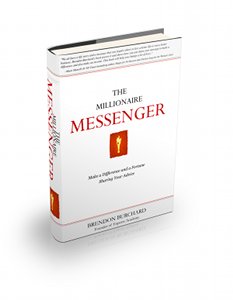
The Millionaire Messenger book cover
Photos: Experts Academy
Everyone has something they are good at and can teach others. So believes Brendon Burchard, a non fiction book author, entrepreneur and speaker. The first step, in Burchard’s opinion, is to figure out what that special something is and know what to do to share it with others willing to learn and pay for the privilege. This way the expert does good and makes a fortune in the process.
In The Millionaire Messenger Make a Difference and a Fortune Sharing Your Advice (Morgan James, March 2011), a The New York Times bestseller (according to promotional materials, The Millionaire Messenger pre-sold 17,000 copies and debuted at the top on The New York Times and USA Today bestseller lists), Burchard outlines his formula for success as a speaker.
The softcover 167-page book is divided into an Introduction and ten chapters: A Crash Course in Sharing My Message, Behind The Guru Curtain, The Expert Calling and Lifestyle, You: Advice Guru, 10 Steps to an Expert Empire, The Millionaire Messenger’s Money Map, The Messenger Mind-set, The Millionaire Mandates, The Messenger Manifesto, and Trusting Your Voice.
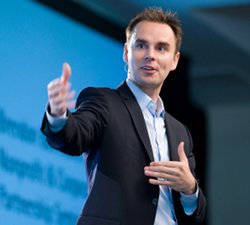
Author Brendon Burchard
The author emphasizes the importance of excellence in the aspiring messenger’s work as well as the motivation to help others and not just to become a millionaire. He also points out that the most important value to strive for is distinction, being different from the pack and offering the audience something of value and uniqueness. He recommends that experts give away the most valuable information; and identifies six areas of profit for Entrepreneur Experts: writing, speaking, conducting seminars, consulting, coaching and marketing online.
Burchard is the founder of Experts Academy. He has been on ABC World News, NPR, Oprah and Friends, and onstage with the Dalai Lama, Sir Richard Branson, Stephen Covey, Wayne Dyer, Tony Robbins, Deepak Chopra, Marianne Williamson, John Gray, Keith Ferrazzi, T. Harv Eker, Tony Hsieh, David Bach, and Jack Canfield, according to his biography.

Click to buy The Millionaire Messenger
Comments:
Filed Under: Books
Posted by Elena del Valle on May 25, 2011
By Jorge Bauermeister
Communications attorney
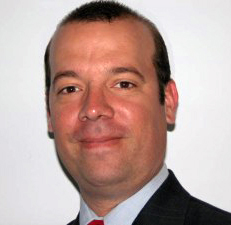
Jorge Bauermeister, communications attorney
Photo: Jorge Bauermeister
In our increasingly interconnected and globalized marketplace, access to broadband technologies has become a prerequisite for success for individuals, businesses and communities. Broadband attracts investment and facilitates the exchange of ideas, information and goods.
Unfortunately, many underserved and minority communities, including Hispanics, are getting left behind because of the persistence of the “digital divide.” The divide exists because minority communities lack reliable access to Internet at home, school and work.
But could the expansion of broadband be the great equalizer? Many experts think so, and they are turning to creative solutions to make expanded broadband access for all a reality.
In a recent post on Mashable, Aliza Sherman highlights several U.S. cities that have launched partnerships with local nonprofit organizations and businesses to bring increased access to underserved communities.1
Click to read the entire article Broadband Access for Hispanics: The Great Equalizer?
Posted by Elena del Valle on May 23, 2011
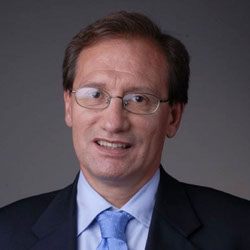
Eduardo Gamarra, Ph.D., managing partner, Newlink Research
Photo: Newlink Research
According to the results of Latinos’ Emotional Connection with Companies and Brands, a 2011 survey conducted by Newlink Research and released recently, the majority of adult Hispanics polled favored companies with Latino community involvement. The study, commissioned by Garcia Trujillo Holdings, LLC, was designed to explore whether perceptions about the way in which domestic large companies and brands treat Hispanics affect the ability of those companies to attract United States Latinos as consumers.
More than 66 percent of survey respondents said they would be more inclined to buy products and services from, and 64.7 percent said they would be even be more loyal to, companies that demonstrate a strong and visible commitment to the Hispanic community.
“Considering that Hispanics make up about 16 percent of the population of the United States and that over the next four decades they will represent the largest growing market segment, U.S. companies should begin to take into account this enormous gap and begin to structure responses that prepare them for the future,” said Eduardo Gamarra, Ph.D., managing partner, Newlink Research and professor at Florida International University. “Hispanic human capital already represents an enormous underutilized resource.”
Researchers concluded that although 59.3 percent of the consumers surveyed said they believe the Hispanic market is important to companies and brands in the United States almost 42 percent of respondents also believe those companies have little respect for them as consumers. Most (94 percent) of the respondents to the survey said they would like companies to have Spanish speaking spokespeople in their advertising and information campaigns and 15.5 percent would welcome products and services designed for Latinos.
At the same time, many respondents, more than 60 percent, said they believe Hispanic workers face serious obstacles to advancement; and 42 percent thought companies provide poor growth opportunities for Hispanics. Nearly 60 percent indicated they believe language and a college degree (21.7 percent) are the main obstacles. Many of the survey takers, 60 percent, said they believe companies are committed to their Latino employees but that few (less than 10 percent) of those employees are likely in management or leadership roles in companies in the United States.
The survey was conducted among 1,100 adult Hispanic consumers residents of the four districts with the greatest concentration of Hispanics in the United States (Southeast, Northeast, Southwest and West) between January 24 and 29, 2011. Bilingual operators conducted 15-minute interviews in English or Spanish according to the preference expressed by individual respondents. The sample took into account standard age, gender, and national origin parameters.
Garcia Trujillo Holdings, LLC offers strategy, execution, organization, and mergers and acquisitions consulting services. Newlink Research is part of Newlink Group, a family of communications and business services firm focused on the United States Hispanic market and Latin America. Newlink America is the U.S. Hispanic division founded and run by Jorge Ortega and Eduardo del Rivero.
Posted by Elena del Valle on May 20, 2011
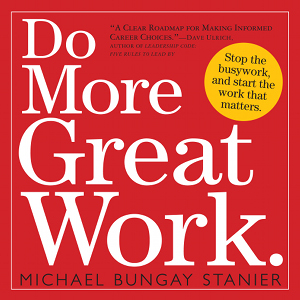
Do More Great Work book cover
Photos: Workman Publishing
Work, work and more work. It seems everyday is filled with work and yet some people feel they are stuck in a rut that keeps them from growing and reaching higher goals. Is it possible to keep working and aspire to grow and develop new skills? How? Michael Bungay Stanier, a Toronto resident and founder of a company that assists companies who want to improve their productivity thinks he knows a way.
In Do More Great Work Stop the busywork and start the work that matters, a 200-page book published last year, he begins by addressing the definition of Great Work. He sees it as work that has impact and makes a difference. Then he outlines fifteen exercises for people who want to improve the quality of their work. He believed so much in his message he self published the book.
The goal he proposes is to identify ways to improve and find work that engages and challenges the worker, has a real impact, plays to his or her strengths and matters. He relies on what he calls Maps or “pause buttons in disguise.”
The softcover square book is divided into fifteen Maps and seven parts: Laying the Foundation, Seeds of Your Great Work, Uncovering Your Great Work, Pick a Project, Create New Possibilities, Your Great Work Plan, and Continuing Your Great Work Journey.
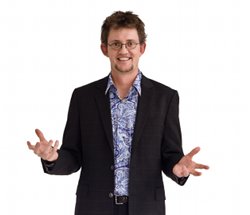
Michael Bungay Stanier, author, Do More Great Work
The author believes by dedicating 10 minutes a day motivated readers of his book will find ways they can produce Great Work, locate the balance between the job requirements and their needs, produce new ideas, manage their workload effectively, and double the likelihood that they will do what they want to do at work.
Bungay Stanier is the founder and senior partner of Box of Crayons, a company that works with organizations such as AstraZeneca and Xerox to help them do more great work. A Rhodes Scholar, he earned arts and law degrees with highest honors from Australian National University and an MPhil from Oxford. He was named Canadian Coach of the Year in 2006.
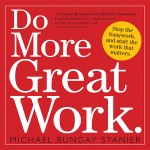
Click to buy Do More Great Work
Comments:
Filed Under: Books
Posted by Elena del Valle on May 19, 2011
Title Spec IIIa – Business Support-0189
Blue Cross and Blue Shield of Florida
City Jacksonville
State FL, 32246
Type Full Time
Job duties include but not limited to the following:
The Consultant will be responsible for proactive analysis and ongoing best practices research
-Assist Leadership Team as needed to execute on diversity data strategy
-Collect, analyze and utilize best in class research to inform multicultural business decisions
-Research and apply for local and national awards
-Collaborate with appropriate departments to leverage existing intelligence sources
-Develop and implement a communication plan to share benchmarking data
-Summarize research findings and make appropriate recommendations
-Ongoing analysis of demographic data
-Analyze employee data to develop conclusions and recommendations, frequency of reports, etc.
Click here to read the entire Title Spec IIIa – Business Support-0189 Blue Cross and Blue Shield of Florida
Posted by Elena del Valle on May 18, 2011
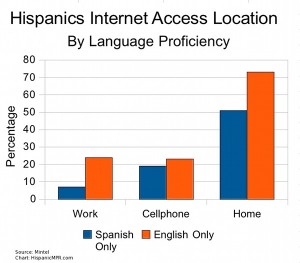
Hispanic Internet Use Location by Language – click to enlarge
A large majority of Hispanics with an income of $50,000 and higher is likely to use the internet while only 59 percent of Hispanics earning $25,000 and under is likely to do so, according to the recently released results of a Mintel survey.
In the same report Mintel indicated that members of blue collar Hispanic households that responded to the survey exhibited minimal internet usage. Many of the individuals in these households worked in positions that did not require use of a computer or access to the internet.
Acculturated Hispanics who live in a household where at least some English is spoken are more likely to surf the web than their less or least acculturated Spanish dominant counterparts, according to the Mintel findings. Most (95 percent) of adults in English only households use the internet compared to only just over half of adults in Spanish only homes.
The researchers believe these Spanish dominant and low income Latino market segments are rife with marketing opportunities for internet use and promotion. Mintel, an international research company, surveyed 531 nationally representative U.S. Hispanic respondents aged 18 and older in October 2010 used to prepare the report, Hispanics Online.
Posted by Elena del Valle on May 16, 2011
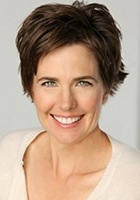
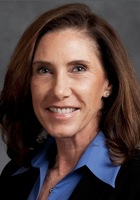
Bonnie Buckner, M.A. and Pamela Rutledge, MBA, Ph.D.
Photos: Bonnie Buckner, M.A., Pamela Rutledge, MBA, Ph.D.
A podcast interview with Bonnie Buckner, M.A., Pamela Rutledge, MBA, Ph.D. co-founders, A Think Lab is available in the Podcast Section of Hispanic Marketing & Public Relations, HispanicMPR.com. During the podcast, they discuss transmedia storytelling with Elena del Valle, host of the HispanicMPR.com podcast.
At their consulting firm they are dedicated to helping companies become more responsive, flexible, innovative and effective by learning to see the world in a new way. Bonnie and Pam conduct workshops and projects on Creativity, Finding the Company Story, Transmedia Storytelling, and the Impact of New Media on Corporate Culture and Messaging. They have developed and teach Transmedia Marketing through Storytelling, a new course for UC Irvine Extension.
Bonnie and Pam are also on the faculty of Fielding Graduate University where they teach media psychology, cognitive psychology and visual design, political psychology, and social media and emerging technologies. They are based on the west coast.
To listen to the interview, scroll down until you see “Podcast” on the right hand side, then select “HMPR Bonnie Buckner, M.A., Pamela Rutledge, MBA, Ph.D.” click on the play button below or download the MP3 file to your iPod or MP3 player to listen on the go, in your car or at home. To download it, click on the arrow of the recording you wish to copy and save it to disk. The podcast will remain listed in the May 2011 section of the podcast archive.
Posted by Elena del Valle on May 13, 2011
Hard Time Life with Sheriff Joe Arpaio in America’s Toughest Jail
A book review by Luisa Fournier-Padró
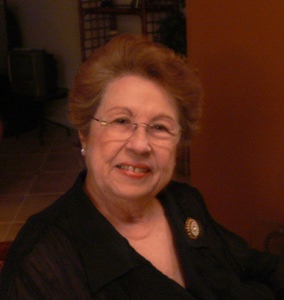
Luisa M. Fournier-Padró
Photos: Luisa M. Fournier-Padró, Skyhorse Publishing Publicity
A British young man leading a structured life he planned would lead him in a VIP limousine straight to Wall Street took a wrong turn, made a poor choice and it led him straight to prison, to an inferno. Caught in the midst of uncertainty, disorder, jumble, bewilderment or mistaken values of life he delivered himself to a nightmare. In the 304 pages of Hard Time A Brit in America’s Toughest Jail (Mainstream Publishing, $13.73) Shaun Attwood recounts his struggle with and life under terrible circumstances at Sheriff Joe Arpaio’s prison in Tucson, Arizona.
According to the book, in this setup and much talked about prison atmosphere, Attwood was able to maintain his sanity and rational behavior through daily meditation of his past actions and dedication to physical and intellectual stimulation plus a strong desire to regain his life back.
In Hard Time, he depicts how the undercurrent of a frenzied style of life most glamorous to youngsters can bring so much heartache after short-lived trance of rave parties high on drugs and acid music. To the reader whose knowledge of these words -rave, acid house and music- seems foreign it takes just a moment to search its meaning and background. The term rave most often is used to describe high in energy music, including some forms of trance music that features loops and synthesizers and, less intense forms that include ambient music and chill out music played at chill rooms that provide place for ravers to rest and relax from the intense dancing plus, what pushers offer youngsters.
Click here to read the entire A book review of Hard Time
Comments:
Filed Under: Books
Posted by Elena del Valle on May 11, 2011
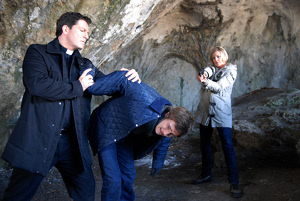
Scene from German series No Mataras
Photo: Vme
In addition to targeting cooking aficionados and young children (see Starting today Vme, National Wildlife Federation to air translated program for preschool kids and National Spanish language TV network offers extensive cooking programming) Vme programming executives want to reach adults 18 to 49 years of age. With that goal in mind the Spanish language network is launching No Matarás, a German produced series making its United States debut on Vme this month. The show was translated into Spanish.
No Matarás (Spanish for You Will Not Kill) features Father Simon Castell (Francis Fulton-Smith), a special commissioner of the Holy See and the Vatican’s personal private eye, and Marie Blank (Christine Döring), his police partner, as a crime fighting duo. Vme plans to broadcast 15 episodes of the hour long program produced by UFA International Film and TV Production GmbH and shot in Rome and Caprarola.
In the program, Father Castell is cast as handsome, outgoing, and tenacious with an atypical personality to match the job the Vatican has assigned him. He is aided in his task by a good sense of humor, a fanatical love of soccer and the ability to crack safes. His partner is a police inspector described as a clever and tough single mom. The two team up to catch crooks and build a sometimes difficult relationship that relies on his knowledge of the church and her knowledge of the streets. The episodes will air at 10 p.m. ET Wednesday nights beginning May 11, 2011.
Vme (pronounced veh-meh) is a national Spanish-language television network presented by public television stations. The 24-hour Spanish network available in 10 million homes, offers drama, music, sports, news, current affairs, Latin cinema, food, lifestyle, nature and educational preschool content.
Posted by Elena del Valle on May 9, 2011
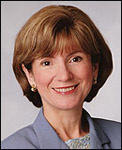
Debra L. Ness, president, National Partnership for Women and Families
Photos: National Partnership for Women and Families, American Association of University Women
On average, full-time working women in the United States are paid $10,622 less than their male counterparts, according to recent research conducted by the National Partnership for Women and Families, in conjunction with the American Association of University Women (AAUW), in all 50 states and the District of Columbia.
In California, for example, where 1,593,474 households are headed by women, there is a wage gap of $8,370 between full-time working men and women. In New York, 1,050,106 households are headed by women and there is a wage gap of $8,590; in Florida 897,308 households are headed by women and the wage gap is $7,013 between full-time working men and women.
The researchers in this case estimate that were the gap to close it would have a dramatic impact on the lives of many families. They point out that in Alaska, but for the gap women could buy 1.7 years’ worth of food; working women in Connecticut could afford 15 more months of rent; their counterparts in Michigan could make 10 more months of mortgage and utility payments; and working California women could buy 2,100 more gallons of gas.
“This new data illustrate the very real harm unequal wages are doing to America’s working families,” said Debra L. Ness, president, National Partnership for Women and Families. “It is long past time to close the gender-based wage gap. With women playing an increasingly important role as family breadwinners, there is no time to waste.”
Although women head nearly 14.5 million households nationwide and the majority of working mothers in the United States are the source of at least a quarter of their families’ earnings, women working full-time are only paid an average of 77 cents for every dollar paid to full-time working men, according to the Partnership. Since the 1963 Equal Pay Act passed the wage gap has narrowed half a cent per year, the research points out; and if it continues the same way, the working women of tomorrow will earn the same as the men by 2058.
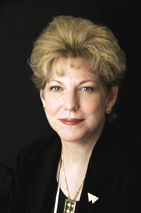
Linda Hallman, executive director, American Association of University Women
“This research proves that the gender pay gap is not simply a numbers issue or a women’s issue,” said Linda Hallman, executive director, the American Association of University Women. “It’s a bread and butter issue. It’s an everyday issue for people who are trying to support their families and provide for their futures. No more lip service, it’s time to act.”
It is harder still for African-American and Latino women. Nationally, in 2009, African-American women working full-time, year-round were paid only 61 cents for every dollar paid to men and Latinas only 52 cents, for every dollar paid to white, non-Hispanic men.
Established in 1971, the National Partnership for Women and Families is dedicated to creating “a society that is free, fair and just. Where nobody has to experience discrimination, all workplaces are family-friendly, and no family is without quality, affordable health care and real economic security.” The mission of the American Association of University Women, a nationwide network of more than 100,000 members and donors, is to advance “equity for women and girls through advocacy, education, philanthropy, and research.”

























